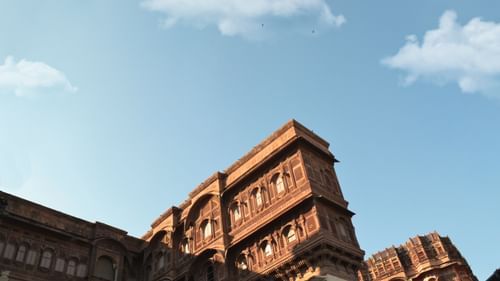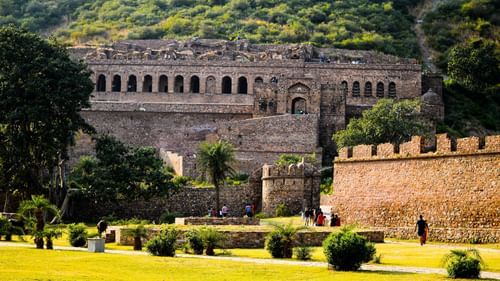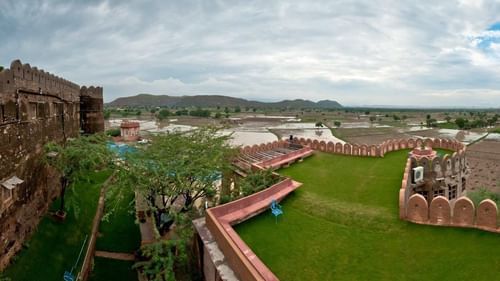Forts and Palaces of Alwar
The magnificent palaces and the sturdy forts of Rajasthan are a testament to the state’s rich cultural background. Alwar is a prominent tourist destination in the regal state that flaunts its architectural grandeur. These historical monuments were built back in the medieval times and give the tourists a glimpse of the culture and traditions of Alwar.
A trip to Alwar is a must. The majestic palaces and forts are the living testament of the land’s powerful and dynamic history. So do not miss out on a visit to some of the most phenomenal monuments and landmarks.
A trip to Alwar is a must. The majestic palaces and forts are the living testament of the land’s powerful and dynamic history. So do not miss out on a visit to some of the most phenomenal monuments and landmarks.

Bala Quila
Bala Quila Fort, also known as Alwar Fort, stands at an elevation of 1000 m. Situated in the Aravalli Ranges, the fort is 5 km long and approximately 1.5 km wide. It was built by Hasan Khan Mewati in the 15th century. Over the centuries, the fort was passed on from the Mughals to the Marathas, then the Jats and finally, the Kachwaha Rajputs. Constructed in a typical Indo-Islamic architectural style, Bala Quila Fort is beautifully adorned with ancient scriptures and sculptures. The fort houses 6 intricately carved gates - Jai Pol, Suraj Pol, Chand Pol, Kishan Pol and Andheri Gate.

Bhangarh Fort
Considered the most haunted place in the country, the towering Bhangarh Fort is located on the Sariska Reserve border in the Aravalli Ranges. It was built in the 17th century by Raja Bhagwant Das. The fort houses four entry gates - Ajmeri Gate, Lahori Gate, Phulbari Gate and Delhi Gate. There are several Nagara-style Hindu temples at the entrance of the Bhangarh Fort, such as Ganesh Temple, Hanuman Temple, Someshwar Temple, and Gopinath Temple. Gopinath Temple is built above a 14 ft. pedestal and is decked with charming stone carvings. The temple complex also houses the residence of the head priest, which is known as ‘Purohitji ki Haveli’.

City Palace, Alwar
Also known as Vinay Vilas Mahal, City Palace is a stunning architectural monument situated in Alwar. The architecture of the palace is a blend of Rajasthani and Mughal and is embellished with beautiful mirror work and murals on the ceilings and the walls. The elevated door-shaped pavilion inside City Palace is the perfect representation of the pride and honour of the Rajput kingdom.
There is an artificial lake within the palace complex that was built by Maharaja Vinay Singh in 1815. Additionally, the palace houses a museum that showcases a wide range of Mughal artefacts. It was built in 1940 by the last ruling king of Alwar - Maharaja Tej Singh Prabhakar Bahadur. City Palace, Alwar is among the few forts in the city that give a glimpse of the royal lives of the Mughal and Rajput kings!

Hill Fort, Kesroli
Built in the 14th century, Hill Fort, Kesroli is among the oldest heritage sites in the country. This seven-turreted fort is believed to have been built by the Yaduvanshi Rajputs. They claimed to be the descendants of Lord Krishna but later converted to Islam to be called Khanzadas. Hill Fort was first conquered by the Mughals and then the Jats, before it was recaptured by the Rajputs in 1775, the same year the princely state of Alwar was formed!
In 1995, the restoration of the fort started. The Neemrana restoration philosophy ensured its architecture was kept as authentic and original as possible, to give the visitors a glimpse of the Rajputs.
In 1995, the restoration of the fort started. The Neemrana restoration philosophy ensured its architecture was kept as authentic and original as possible, to give the visitors a glimpse of the Rajputs.
On your visit, make sure to pamper yourself to a glamorous stay at one of the best heritage hotels in Kesroli - Neemrana Hill Fort. The regal hotel presents magnificent backdrops for destination weddings and events. Guests are treated to immaculate accommodations and dining facilities that create an unforgettable experience. So come explore Kesroli in its truest form!